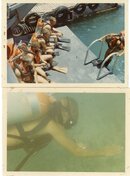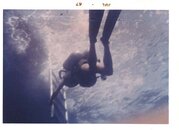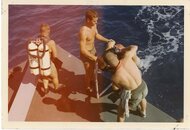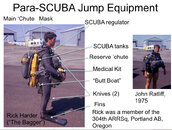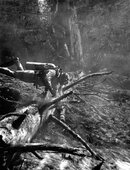Okay, I’m going to give a bit more information here, some of which you may not be aware of. First, let’s talk about the BCD. Many people now think of it as a life-saving device, in spite of the fact that many of the designs will not float a diver face-up in an emergency where the diver is unconscious.
Second, think about the acronym, ”BCD.” It stands for “Buoyancy Compensating Device.” These were developed when the compensation was for the loss of buoyancy of a wet suit. We did not use them with dry suits because they did not loose buoyancy as the diver descended. I dove the original Aquala dry suit. I did not use a BCD with it (primarily because they had not been developed yet).
Now, let’s talk about diving sans a BCD. Some have referenced that we did that in the ol’ days. Well, I started diving in 1959, and got certified in 1963. In those ol’ days, we had no BCDs, as they didn’t exist. In fact, I had a hand in developing the BCDs, and talked at two international conferences about those ideas in the 1970s (NAUI’s IQ 6 and IQ 7).
I remember in about 1959 or 1960 when I was diving solo with my family off a 7-man life raft that included my brothers (3), my Dad, and my Grandmother. I was diving in Elk Lake in Oregon, and having a ball. No BCD. Actually, no wetsuit too, so I got a bit chilled. My Grandma got irritated and worried about me (being about 15 years old at the time), and finally had enough, and demanded to my Dad, “Tell him to come up, Tell him to come up!” My Dad turned to her and simply said, “How?” I came up about ten minutes later; ’didn’t find out about that until just a few years ago.
I was trained by the U.S. Navy in the Naval School for Underwater Swimmers in 1967. We had no BCDs, but what nobody here has stated is that we did have dive vests, with CO2 inflator systems. In that same year, I went through the U.S. Air Force’s Pararescue Transition School (our last of a number of schools). In it we learned parascuba jumping for use in situations where we had a survivor off shore or in a boat, or in a spacecraft capsule (such as Gemini VIII; I was trained on Apollo rescue techniques). We had no BCD then either, but we always work our underarm life preservers (LPU—life preserver, underarm) too.
I did dive sans BCD with my wet suit at times when recreational diving, but during those times we had our weight belts with a quick release to dump in case of any emergency.
So we had multiple ways or maintaining surface buoyancy without the BCD. The problem that the BCD solved was loosing buoyancy as we descended beyond 20 or so feet, and the wet suit’s closed-cell neoprene compressed until it had very little to no buoyancy at all at about 50 feet in freshwater (I checked that, by taking my weight belt off and tying it to the boat’s anchor line, only to be picked up later just before ascent). Drysuits don’t have that problem, but are less hydrodynamic, and now with the addition of a BCD they are even less streamlined in the water (but that doesn’t matter now as no one actually kicks to provide forward motion more than about 1/4 mph).
When I went through my NAUI ITC, we did not have any BCDs. Instead, we all work CO2 vests; now I cannot even buy a CO2 vest, as the manufacturers won‘t make them because some idiot tried to breathe off one and died, and they got sued. So that option no longer exist; you can only buy a snorkeling vest with an oral inflator now.
I hope this gives a bit of perspective on the ol’ days of diving.
SeaRat
PS, I’ll provide some photos when I get up to my upstairs computer; I’m on my iPad now.




